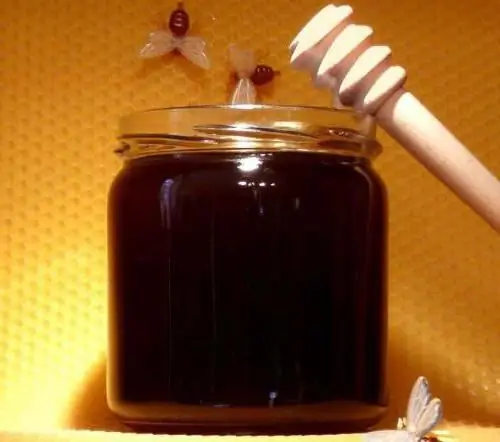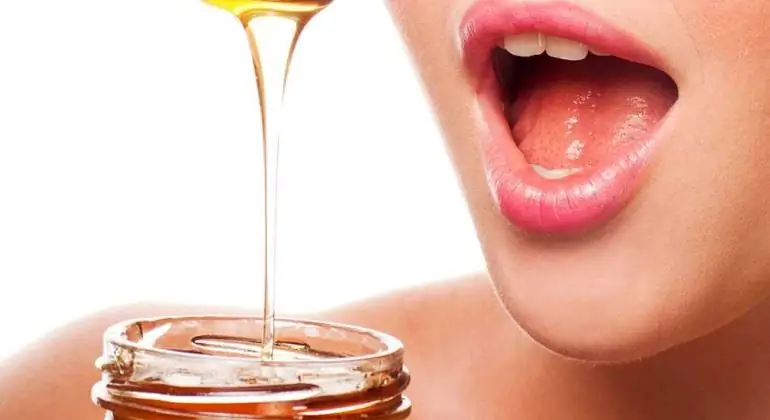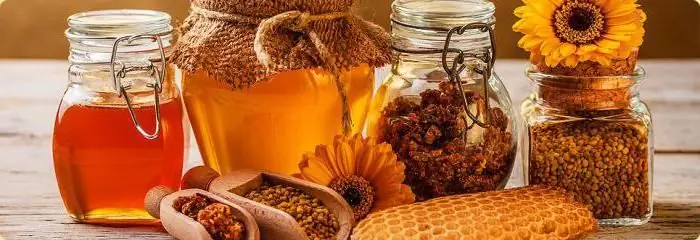2025 Author: Isabella Gilson | [email protected]. Last modified: 2025-01-23 12:50:33
The taste of honey has been known to people since ancient times. Avicenna spoke about its beneficial influence. But only high-quality natural honey can have a healing effect on the human body. Varieties of this unique product differ from each other in taste, texture and composition of trace elements.
What is honey like?

Depending on the plants from which the nectar was collected, honey is divided into polyfloral and monofloral.
Monofleur honey contains 60-90% nectar from one plant. It is extremely rare in its pure form; in order to obtain it, some kind of honey plant must prevail in the area of the summer of bees. For example, pure linden honey can only be obtained in the Far East (where it is the main honey plant). Most often this is possible when a certain agricultural crop is cultivated nearby.
Polyfloral honey is collected from various plants in approximately the same proportions. Monofloral varieties do not surpass polyfloral honey in useful qualities.
Varieties of honey depending oncollection places: steppe, meadow, forest, mountain, fruit. There are also geographical divisions into "Altai", "Bashkir", "Far Eastern" honey and so on.
Species by botanical origin
Bees do not only make their honey from flower nectar. Varieties of natural honey - flower (nectar processing product), honeydew (made from honeydew and honeydew) and mixed (consisting of honeydew and flower honey). Pad is a thick sweet secretion of insects that live on plants and feed on their juice. Bees willingly collect it for processing. Honeydew honey is not so tasty, but has special healing qualities and is considered one of the most valuable varieties in Europe.

Varieties of honey and their properties
According to the method of pre-sale preparation, honey can be of two types: honeycomb and centrifugal. Centrifugal honey is more popular, honeycomb honey is more useful. Wax is an ideal storage for honey, comb honey retains biologically active substances and vitamins much longer.
Separation by consistency
There is a division into liquid and shrunken (crystallized) honey. Varieties of honey by viscosity: very liquid, liquid, thick, gelatinous.
Crystallization is a natural process, as a result of which healing properties are not lost. Dried honey is coarse-grained, fine-grained and greasy in consistency.
The species also differ in color, transparency, taste and aroma.

Valuable, unique and common honey
Varieties of honey according to taste can be conditionally divided into rare and ordinary varieties. Ordinary, commonly produced: sweet clover, sunflower, rapeseed, buckwheat. Clover, linden, buckwheat, sweet clover honey are considered the best in composition, healing and taste qualities.
Unique varieties include pure linden honey, raspberry, angelica and acacia. Honey collected from acacia is almost transparent and very liquid. It can stand without sugaring for up to three years.
Honey is a very strange item…
Sellers often let their imagination run wild and, in pursuit of the exotic, invent incredible types of honey. So, forgetting biology lessons at school and boldly endowing coniferous plants with non-existent flowers, sellers began to promote such species as "Pine", "Cedar", "Cypress", "Fir" and so on. These varieties are considered artificial. They have nothing to do with natural honey. They are made from molasses with the addition of flavorings and dyes.
The same can be said about Sea Buckthorn, Rosehip and Chamomile honey products. These plants have pollen, but cannot be honey plants - they do not produce nectar at all or produce very little nectar.
Very little nectar is given by the flowers of wild strawberries, strawberries, thistles, yarrows. And ginseng and Rhodiola rosea (golden root) are so rare that honey cannot be obtained from them.
People who want to improve their he alth with the help of such a product should understand that natural honey is of high qualitycan only be obtained from honey plants that grow in large numbers within a radius of 6 km. from the apiary. And paying 800 rubles for a sweetener with a promising name is stupid.
Recommended:
Which honey is the most delicious? Description of honey varieties

Nature gave us a tasty and he althy medicine - honey. Everyone knows that there are a great many types of this bee product. Each variety has its own flavor properties. But which honey is the most delicious? This question cannot be answered unequivocally, as our tastes differ. And in order to make a choice, you should know how the varieties of honey differ and what affects the taste of the product
Dark honey: properties and varieties. How dark honey is harvested

Honey is one of the most valuable natural products ever given to humanity by Mother Nature. Our distant ancestors knew about its unique properties. It contains about 190 different chemical compounds. Dark honey is considered especially useful. From which plants of central Russia this product is obtained, you will find out by reading today's article
Water with honey. Honey with water on an empty stomach for weight loss. Honey with water and lemon

The issue of losing weight must be approached responsibly so that the desire for harmony does not turn out to be a road to loss of he alth. Honey with water on an empty stomach for weight loss is effectively used all over the world. In addition to the fact that the body gets rid of excess weight, it simultaneously heals
How to identify good honey? What should be real honey? The best varieties of honey

Honey is a natural product produced by Apis mellifica bees from flower nectar. It not only has an excellent taste, but also strengthens and nourishes the human body. Its production is a long-term, labor-intensive process, so the high price of good honey should not surprise you
What types of honey are there? Dark, white and rare varieties of honey. What variety is the most useful?

"Honey" has a very unusual meaning - in translation, the word means something mysterious, enigmatic, endowed with some kind of magical properties. And this is not surprising, because this product is able to cure any ailments, cope with serious diseases, and also endow with vitality, beauty and wisdom. What are the varieties of honey? The answer to this question will be detailed, since this product is also classified depending on its origin and application technology

